After their decade of rapid growth left no corner of the globe untouched, the major Gulf carrier have entered an unsettled period, necessitating a more nuanced approach to network development.
Emirates, Etihad and Qatar Airways have all had to rethink strategy over the past couple of years to combat challenges. These have in some ways been a product of their own rapid expansion, but in many cases have been prompted by factors outside their control.
The three carriers face different problems and have differed in their capacity-planning over the past year. However, there are some common themes. The Gulf giants were significantly affected by the various security and travel restrictions implemented by the USA in 2017.
Though restrictions enforced on US-bound flights – requiring personal electronic devices to be checked, and banning travel from certain Muslim-majority countries – were short-lived, they had an important impact on North American demand. Indeed, Emirates Airline president Tim Clark described these as having hit the carrier as hard as anything other from 9/11.
Meanwhile, the long-rumbling subsidy row between the US majors and the Gulf carriers heightened, compromising their existing co-operation. American Airlines, for example, ended its codeshares with Etihad and Oneworld partner Qatar Airways amid the spat, a move the Abu Dhabi carrier cited in dropping flights to American's Dallas/Fort Worth hub.
Tensions have since eased following the respective US government agreements with Qatar and the United Arab Emirates earlier this year, helped by a lack of any plans by the Gulf carriers for additional fifth-freedom routes to the USA. This was among the most contentious parts of the argument. Emirates is the only carrier to operate such flights, with services linking Athens and Milan to Newark and New York JFK, respectively.
But while many of the factors causing a drop in demand have been resolved, the underlying picture remains one of stalled growth in the US markets – at least in capacity terms.
FlightGlobal schedules data for September shows the three Gulf carriers' combined North American capacity was down by all measures compared with the same month in 2017, with a near-3% cut in seats and ASKs, and a reduction of almost 4% in terms of flights. Compared with two years ago, North American flight and ASK capacity were down 7%, while seat capacity declined nearly 6%.

Two routes have been cut and one added since September 2017. Etihad dropped its Abu Dhabi-San Francisco route in addition to its Dallas/Fort Worth service. Emirates added new Dubai flights to Newark, but also cut capacity by a similar margin on its existing New York JFK service. Emirates has also reduced its Seattle capacity, while Qatar trimmed seat capacity on its Atlanta and Houston services from Doha.
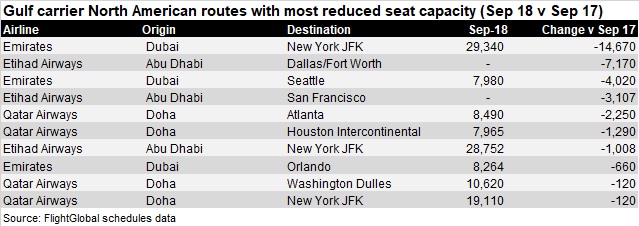
Emirates has increased its seat capacity on six existing North American routes, however, notably Toronto, Houston and Washington Dulles. Etihad raised its seat capacity on Los Angeles, while there have been small increases by Qatar on its Dallas/Fort Worth and Los Angeles routes.
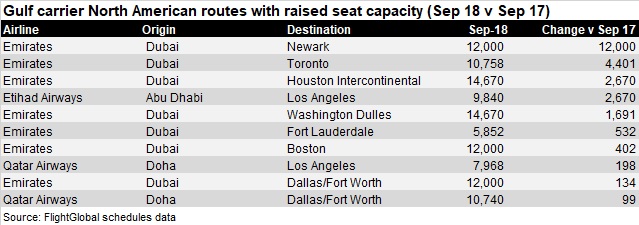
ETIHAD AIRWAYS
But each, too, has faced its own specific challenges, some of which remain in play now. The most high-profile of these are Etihad's. The airline has been one of the most proactive and dominant players in recent years, embarking on a series of investments to support an expansion strategy aimed at fast-tracking its place – and that of its Abu Dhabi hub – on the global stage.
That strategy began unravelling last year with the departure of its architect, group chief James Hogan, and when the Abu Dhabi carrier balked at further bailing out of Air Berlin and Alitalia. The German carrier collapsed and its prized assets were swiftly picked up by many of the rivals that had put its operations under so much pressure. The fate of Alitalia, which will try once again to secure another investor, should become clearer during October – the latest of several deadlines for a decision on new investors.
Etihad's new chief, Tony Douglas, took the helm at the start of 2018 and the carrier has since been in a period of relative introspection. It appears to be in no rush to abandon the partner strategy. While stakes in Alitalia, Air Berlin and Darwin Airline have been sold or allowed to dwindle, Etihad has more recently reaffirmed its partnership in Air Serbia and Jet Airways, and retains stakes in Air Seychelles and Virgin Australia.
But the Abu Dhbai carrier has not shown much interest in adding to its roster of partners. A serial acquirer of airline stakes in the first half of this decade, it has bought none since buying into Alitalia at the end of 2014. Neither has there been much by way of significant new non-investment partnerships, since a preliminary Lufthansa deal that was detailed at the start of last year.
Instead, Douglas has put the focus closer to home. At the start of July, he outlined a group restructuring under which he took direct responsibility for Etihad's core operation. That came shortly after the group revealed a net a loss of $1.5 billion for its last financial year. The result had been dragged down by its Air Berlin and Alitalia investments, but also reflected the need for an overhaul at the airline itself.
Douglas said the company had been "improving the quality" of its revenues and "streamlining" its cost base. "These are solid first steps in an ongoing journey to transform this business into one that is positioned for financially sustainable growth over the long term," he says, but he acknowledges a "crucial" need to maintain momentum.
Part of this strategy has been more capacity discipline. FlightGlobal schedules data shows that Etihad doubled its capacity in ASK terms in the five years up to September 2017, which is illustrative of its rapid expansion. But this September's figures show a 4% cut in ASK capacity over the past 12 months.

Schedules data shows that the Abu Dhabi carrier has dropped seven routes since September 2017, to Dallas/Fort Worth and San Francisco in the USA, Entebbe/Kampala in Uganda, Venice in Italy, Jaipur in India, Ho Chi Minh City in Vietnam, and Iranian capital Tehran.
Over the same period, Etihad has added one new route, a service to Baku in Azerbaijan.
There have also been notable reductions in seat capacity to Bangkok, Calicut, Delhi, Kuala Lumpur, Manila, Melbourne and Riyadh – although the carrier still retains a large presence on many of these routes.
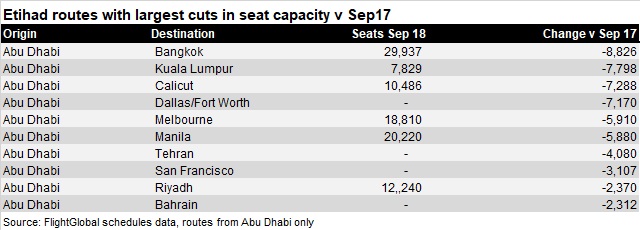
Eithad has lifted seat capacity on several existing routes, though. Notably, that includes services to Rome, Frankfurt and Amsterdam. On Rome, the carrier has replaced a daily frequency after Alitalia ended operation of its Abu Dhabi flights.
Other routes on which Etihad has raised frequency illustrate a shuffling of its services in several countries and regions. For example, while it has dropped two US services, it has raised seat capacity to Los Angeles. Likewise, capacity has been trimmed to Perth and Melbourne but raised to Sydney. The carrier has also significantly lifted seat capacity to Cairo, Lagos and Lahore.
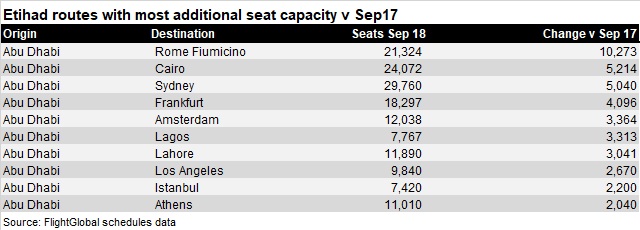
EMIRATES
Etihad's fellow UAE carrier Emirates also undertook major changes. Alongside the changes to its North American network, the wider challenges prompted a tighter partnership with sister carrier Flydubai. The two airlines have already embarked on codesharing as part of an alignment of their networks, enabling Flydubai to feed into Emirates' long-haul flights.
Emirates' new services over the past 12 months focus on fresh airports in key cities – for example the addition of flights to London Stansted, Newark and Istanbul's Sabiha Gokcen airport. The carrier has also added flights to Nigerian capital Abuja, in what has otherwise been a relatively quiet 12 months for new destinations.
FlightGlobal schedules data shows that Emirates has lifted capacity in terms of seats by 3% and ASKs by 6% since September 2017. This is relatively modest growth for an airline that had increased capacity by 50% in the previous five years.
Emirates has cut back its capacity to New York JFK – although largely replaced by its Newark launch – and on another of its US services, Seattle. Other routes with notable capacity reductions include Jordanian capital Amman, Kuwait, and Basra in Iraq – though Flydubai has lifted its capacity for the latter over the same period – as well as Nairobi, Jakarta and Bangkok.

Emirates has raised capacity across a number of routes, though – notably the Australian pair of Brisbane and Sydney, as well as Lagos, Denpasar, Riyadh and the European cities of Lisbon and Brussels.
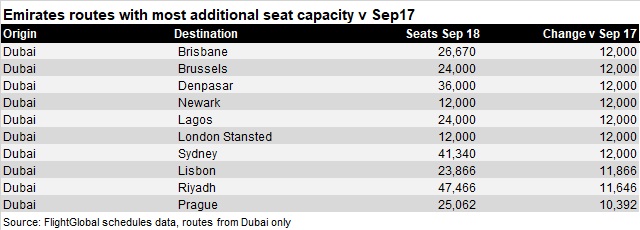
QATAR AIRWAYS
Qatar Airways not only faced the same demand issues as its Gulf rivals, but also the requirement for an almost overnight reshaping of its network as a result of the closure of airspace by several neighbouring states amid an ongoing diplomatic spat in the region. That airspace closure has been in place since June 2017.
Unlike Emirates and Etihad, Qatar Airways has continued to expand its capacity apace. FlightGlobal schedules data shows the carrier has lifted capacity in terms of seats by 16% and ASKs by 15% since September 2017. That is in keeping with the growth rate set when it doubled capacity over the preceding five years.
The data shows that Qatar is this month operating 13 routes it did not operate in September 2017. Many of these are in Europe. They include London Gatwick and Cardiff in the UK, as well as St Petersburg, Sarajevo and resort destinations in Spain, Greece and Turkey – including Malaga, Thessaloniki, Antalya and Bodrum.
Alongside new routes to Hanoi in Vietnam and Penang in Malaysia, Qatar has also stepped up capacity on a number of other Asia-Pacific routes in the past year. These include Bangkok, Dhaka, Ho Chi Minh City and Sydney.
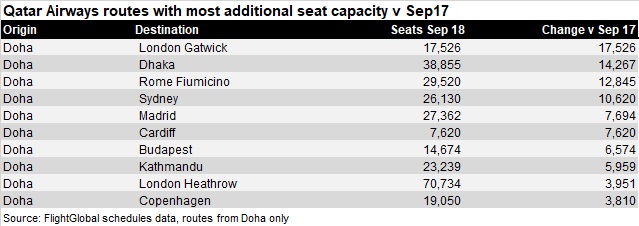
The carrier has also lifted capacity on services to Milan Malpensa and Rome Fiumicino in Italy – a market of increased interest to the carrier since it invested in and helped to revamp Meridiana as Air Italy.
Data shows Qatar has cut no services and trimmed capacity on only 20 of its 159 routes from Doha since September 2017. The most sizeable cuts are on its services to Khartoum in the Sudan and Najaf in Iraq.
For more stories from World Routes, visit flightglobal.com/Routes
Source: Cirium Dashboard






















